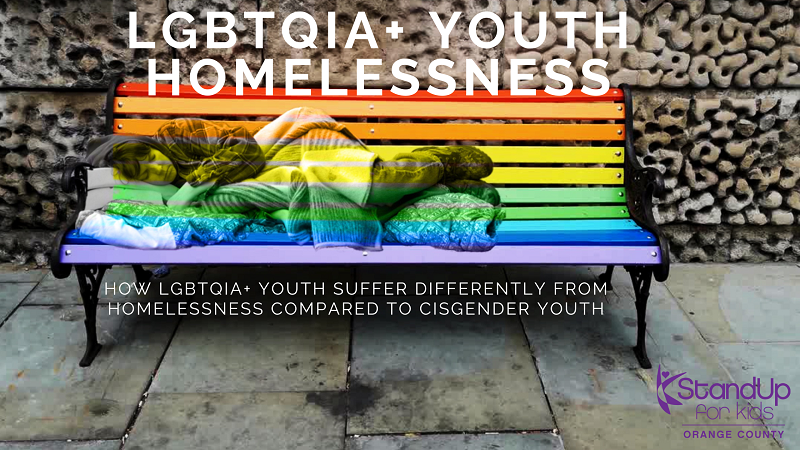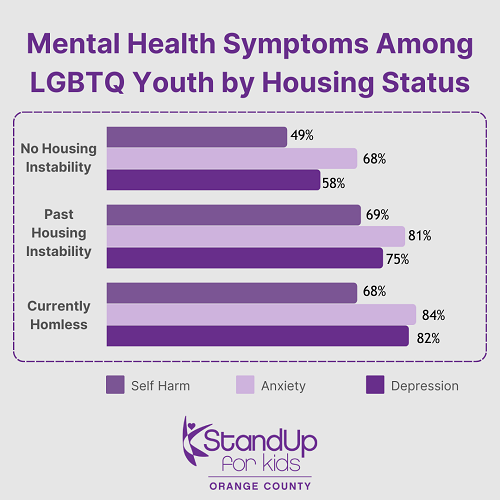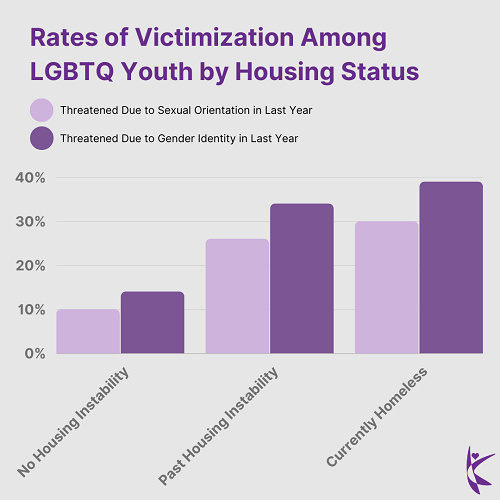StandUp for Kids – Orange County

Homelessness and Housing Insecurity Affects LGBTQIA+Youth’s Potential for an Accepting Successful Future
One in four young transgender adults (between ages 18 through 25) endure homelessness. About 12.5% of the 18 through 25-year old age group report experiencing homelessness. Youth are on the streets for different reasons. Some reasons are drugs, pregnancies, or desire for freedom. In some cases, LGBTQ youth expereince homelessness or housing instability because of their identity.
The 2021 National Survey on LGBTQ Youth Mental Health observes the influence homelessness and housing instability has among LGBTQ youth. It also analyzes the different identities within the LGBTQ community and how homelessness influences their health.
- Homelessness and housing instability was reported with higher rates among transgender and nonbinary youth
â—‹ 38% transgender girls/women
â—‹ 39% transgender boys/men
â—‹ 35% nonbinary youth
â—‹ 25% cisgender LGBQ youth

LGBTQ youth are sometimes neglected by their families. This can lead to abandonment or being kicked out of their home. Certain situations can result in mental, physical, and emotional abuse for the youth from their friends or families. Some youth are too scared to speak up and accept their identity and they decide to run away themselves. They feel unsafe in their homes to express their true selves.
- 55% of LGBTQ youth ran away from home from fear of mistreatment or actual mistreatment because of their LGBTQ identity
- 40% were kicked out of their homes or abandoned because of their LGBTQ identity
Homeless LGBTQ youth are more vulnerable to dangerous risks compared to straight cisgender youth. They are more likely to experience substance abuse which leads them to violent interactions. More injuries and unwanted sexual acts are reported from LGBTQ youth compared to cisgender youth. LGBTQ youth living on the streets engage in survival sex, sexual intercourse in exchange for money, food, or even shelter.
Survival sex is a gateway to other dangers for LGBTQ youth. They engage in unprotected sex, sex with drug abusers, sex workers, or people with HIV and STDs. Sexual and drug abusers take advantage of LGBTQ youth who feel disposable and desire to be wanted. They replace the absence of love and support they didn’t receive from their parents with manipulation from their abusers.
Emotional and mental abuse jeopardizes LGBTQ youth’s health and development. They suffer from mental illness and experience higher rates of victimization. Some youth become numb to the abuse and don’t recognize they could have a mental illness. Those who do seek assistance are often unsuccessful. Homelessness and housing instability can sometimes prevent them from quality mental health care on a regular basis.
- Youth experiencing housing instability are two to four times more likely of reporting mental illnesses such as; depression, anxiety, self-harm, and suicide
- 63% youth who reported housing instability and currently homeless also reported a suicide attempt within the last year
- 3 times more likely to be physically threatened or abused because of their sexual orientation, transgender and nonbinary identity, or gender identity

Youth in the LGBTQ community experiencing homelessness or housing instability reported structural barriers and hesitation for accessing mental health care. Due to lack of transportation, financial insecurity, and no parental permission they were denied quality mental health care. In some cases, they feared entering mental health facilities because of past negative experiences with professionals. They feared their visited would center around their LGBTQ identity so they wouldn’t benefit from the same resources as cisgender youth.
- 53% of youth experiencing homelessness reported wanting mental health care were unable to receive it
- 61% of LGBTQ youth experiencing homelessness or housing insecurity reported they could not afford mental health care
- 33% LGBTQ youth reported they could not reach the location for mental health care
Without the proper resources, LGBTQ youth experiencing homelessness and housing insecurity are unable to work towards a brighter future. They suffer greater challenges compared to cisgender youth.
The Trevor Project, founded in 1998, is the world’s largest crisis hotline for LGBTQ youth available 24/7. They focus on suicide prevention among the LGBTQ community. Their vision, “A world where all LGBTQ young people see a bright future for themselves,” strives to support LGBTQ youth towards a better future.
